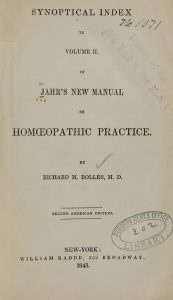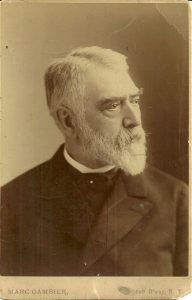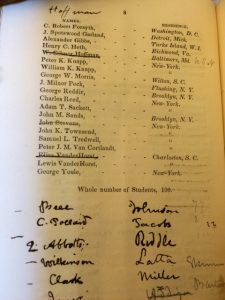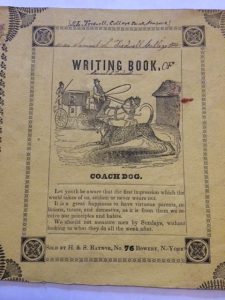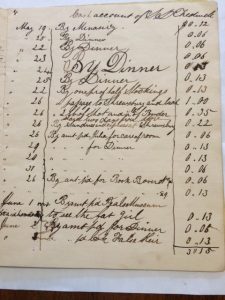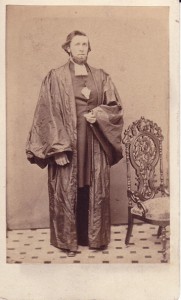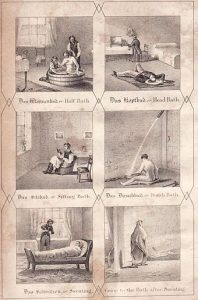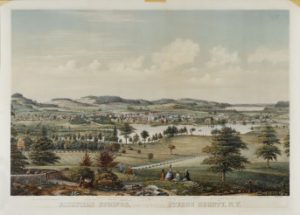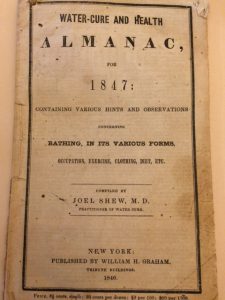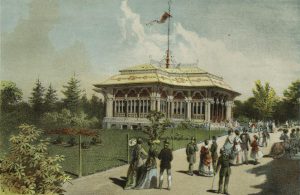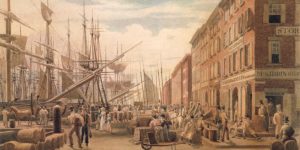The Doctor in the House is a Homeopath!
by Ann Haddad
A Discovery in the Archives
Among the papers in the Tredwell family archives are notes, copied by a staff member from Seabury Tredwell’s personal ledger, that date from 1851 until his death in 1865. (Unfortunately, the ledger is missing.) Judging by his detailed entries of monthly debits and credits, Seabury kept a tight hold on his family’s purse strings. He carefully included expenses both large and small, such as his pew rental at St. Bartholemew’s Church in 1851 ($300), frequent carriage rentals ($8 average), and 16 hams ($29.25).
The most exciting information gleaned from Seabury’s ledger book, however, relates to payments to various physicians for 18 house calls made during those 14 years. Based on standard medical practice of the time, that would have meant a lot of purging and bloodletting. But most likely, not a drop of blood was shed in the Tredwell household in the name of therapy; for in researching the medical practices of the six doctors who ministered to the Tredwell family, it was discovered that, far from being mainstream practitioners, they were all non-traditional homeopaths.
The Typical Treatment: Arsenic and Leeches
Prior to the development and gradual acceptance of germ theory in the mid-to-late 19th century, summoning one’s physician to treat an illness was risky at best. Orthodox medical practice offered little in the way of treatments, and the choices were harsh, potentially toxic and painful, and largely futile. Mercury, arsenic, and lead were used to elicit violent purging and vomiting; bloodletting and use of leeches caused severe anemia, which only worsened the patient’s condition. As a result, laymen developed a severe distrust of physicians, and expressed their doubts and criticisms publicly.
The Emergence of Homeopathy
| . |
As “regular” physicians (or allopaths) struggled to identify more evidence-based treatment modalities, homeopathy emerged as a sophisticated and gentler alternative to the barbaric practices of regular medicine. The origin of homeopathy dates to the work of the German physician Samuel Hahnemann (1755-1843). It was introduced in the United States by Hans Burch Gram (1786-1840), who began practicing medicine in New York City in 1825. Treatment was based on the “Laws of Infinitesimal Dose” and the “Law of Similars,” in which minute and extremely diluted doses of medicines were administered to produce symptoms similar to those of the disease being treated, thereby allowing the body to naturally heal. This was perceived as a gentler, more holistic approach to treating disease.
The recovery rates of patients treated with homeopathy were higher than those treated by orthodox medicine, simply because the new remedies did little or nothing to harm the patients. The apparent success of this new approach, especially during the cholera epidemic of 1832, led many regular physicians to seriously consider “converting” to more homeopathic remedies. Many of these were physicians who had trained at highly regarded allopathic medical schools.
.
The Practice Grows
In 1834-1835, both the New York Homoeopathic Society and The American Journal of Homoeopathia were established. By 1844, the number of practicing homeopaths in the United States had grown to such an extent that the American Institute of Homeopathy was formed. In 1860, the Homoeopathic Medical College of New York was opened and by 1900, the city had more than 100 homeopathic hospitals, clinics, and dispensaries, including one on Bond Street, two blocks away from the Tredwells’ home.
If Mark Twain Believes in It …
Many highly respected public figures of the day espoused the benefits of homeopathy, thereby contributing to its increasing popularity. Henry Wadsworth Longfellow, William Cullen Bryant, Daniel Webster, and Henry James were advocates of its methods. Homeopathy was also very popular among women, including authors Harriet Beecher Stowe and Louisa May Alcott, and members of the clergy. Mark Twain, another believer, said in 1890 that homeopathy:
“…Forced the old school doctor to stir around and learn something of a rational nature about his business, … And you may honestly feel grateful that homeopathy survived the attempts of the allopaths to destroy it.”
The number of homeopaths in New York City grew from 93 in 1857 to 322 in 1904, which was over 15 percent of all practicing physicians.
Traditional Medicine vs. “Quackery”
The reaction by the majority of mainstream physicians and pharmacists to the new practice of homeopathy was fierce and prolonged. Labeled as “quacks” and “irregulars,” homeopaths were perceived as a threat to the medical establishment, for financial as well as theoretical reasons. The traditional physicians were losing patients, and the apothecaries lost business, because homeopaths typically prescribed one medication at a time, and in minute doses. In 1847, the established members of the New York medical community united against the practice of homeopathy and formed the New York Academy of Medicine, and on February 3rd of that year, the first President of the Academy, Dr. John Stearns, had this to say about homeopathy in his inaugural address:
“No man in the full exercise of his reason can believe in the truth of this strange doctrine; and if he attempts to practice upon the principles which that doctrine inculcates, he must possess a depraved moral faculty.”
That same year, the American Medical Association was founded, largely to impose severe restrictions on all forms of alternative medicine. The battle of the allopaths and the homeopaths was fought in the newspapers. The following anonymous poem, which appeared in the Brooklyn Daily Eagle in November 1849, lambasts the heavily diluted therapies prescribed by homeopaths:
“Take a little rum,
The less you take the better,
Mix it with the lakes
Of Wenner and of Wetter.
Dip a spoonful out–
Mind you don’t get groggy–
Pour it in the lake
Winnippisseogee.
Stir the mixture well,
Lest it prove inferior;
Then, put a half a drop
Into Lake Superior.
Every other day
Take a drop of water;
You’ll be better soon,
Or at least you ought to.”
Seabury Tredwell Meets Homeopathy
We do not know why or when Seabury Tredwell began to turn to homeopaths for his family’s medical care. There were at least four physicians in his immediate and extended family; although the nature of their practices is unknown, they were most likely allopaths. Seabury may have been influenced by colleagues in the mercantile world, two of whom, Robert B. Folger and Ferdinand Little Wilsey, studied homeopathy and established medical practices after being successfully treated by Dr. Gram in 1826.
| . |
Who Were These Guys?
Whatever his motivation, records indicate that between 1853 and 1865, Seabury relied exclusively on homeopathic physicians. Dr. Richard M. Bolles (1797-1865), made the most frequent house calls to the Tredwell family between 1853 and 1861. He adopted the tenets of homeopathy in 1840, and his practice diminished as a consequence. Bolles remained an advocate of this alternative treatment, and served as president of the Hahnemann Academy of Medicine. He also worked in several of the homeopathic dispensaries in the city. His Poetic Descriptions of the Chest-Pains and their Appropriate Remedies was famous among homeopaths. Dr. Bolles’ bills to the Tredwell family over eight years totaled $693. He died in August 1865, five months after the death of his patient, Seabury Tredwell.
Dr. Benjamin F. Bowers (1796-1875), who was considered very influential on the growth of homeopathy in New York, made one visit in 1853 to the Tredwells’ farm in Rumson, New Jersey. Dr. Bowers was expelled from his position at the New York Dispensary in 1839 for providing non-traditional medical care. He later served as president of the Homeopathic Medical Society of New-York, and was involved with the Protestant Half-Orphan Asylum (as was his colleague Dr. Bolles, who served as Medical Supervisor), a charitable institution that:
“… has been exclusively under homeopathic treatment for the past 24 years with the most gratifying results, having had an average mortality as compared with all the other asylums in the city, of only one to three.”
Dr. George Belcher (1818-1890), who ministered to Seabury Tredwell during his final illness in March 1865 (Dr. Bolles having retired some years prior), had one of the largest medical practices in New York City. An 1839 graduate of Columbia College of Physicians and Surgeons, he “converted” to homeopathy in 1844. He signed Seabury Tredwell’s death certificate, listing Bright’s Disease (now nephritis, or kidney disease), as the cause of death. On December 31, 1865, he submitted his bill for $70 for his final visit to the Tredwell home on East 4th Street.
Following in Father’s Footsteps
After his death in 1865, at least one of Seabury’s children continued to turn to homeopaths for medical treatment. Elizabeth Tredwell Nichols (1821-1880), Seabury’s oldest child, was a patient of Dr. John Samuel Bassett (1830-1912), a Harvard-trained physician with a practice on West 31st Street, near the Nichols’ residence on Fifth Avenue and 34th Street. Dr. Bassett was a highly regarded physician to many of New York City’s most distinguished families, including the Astors, Chandlers, and Rhinelanders. A respected member of the American Institute of Homeopathy, Dr. Bassett was frequently consulted by other physicians because of his skills as a diagnostician. In 1880, he attended Elizabeth in her final struggle with chronic bronchitis. Elizabeth was 59 years old at the time of her death.
Demise, Then Resurgence
After the turn of the century, the popularity of homeopathy gradually declined as a result of the increasingly scientific approach and rational treatments of regular medicine. By 1923, only two homeopathic colleges remained in the United States, and by 1950 they too had closed.
Within the past 40 years, homeopathic medicine has re-emerged onto the medical scene. It is not unusual for mainstream physicians who focus on a holistic approach to patient care to incorporate homeopathy in their practices, and homeopathic remedies are sold in pharmacies alongside traditional medicine. The Tredwells, no doubt, would feel perfectly at home.
Sources:
- Bowers, Benjamin F. “Opposition to Homeopathy in New York,” in The North American Journal of Homeopathy. Vol. 15, May, 1867, p 580-604. http://books.google.com. Accessed 9/26/16.
- Bradford, Thomas Lindsley. Biographies of Homeopathic Physicians, Vols. 3, 4, 19, 21, 22: Beach-Bixby. Philadelphia, 1916. www.archives.com. Accessed 9/22/16.
- Brooklyn Daily Eagle. Friday, November 9, 1849. www.newspapers.com. Accessed 9/30/16.
- Duffy, John. History of Public Health in New York City, 1625-1866, Volume 1. New York: Russell Sage Foundation, 1968. p. 464-471.
- “Homeopathic Directory.” New England Medical Gazette. April, 1871, p. 190-191. www.archive.org. Accessed 9/8/16.
- King, William Harvey, Ed. History of Homeopathy and Its Institutions in America. New York: Lewis Publishing Co., 1905. www.archive.org Accessed 9/28/16.
- Starr, Paul. The Social Transformation of American Medicine. New York: Basic, 1982.
Ullman, Dana. A Condensed History of Homeopathy. www.homeopathic.com. Accessed 2/28/16.
Samuel Tredwell’s School Days
by Ann Haddad
Back-to-School!
September was a busy month for Eliza Tredwell. After spending summer vacation at the family farm in Rumson, New Jersey, this mother of seven children (ranging in age from 3 to 17), returned to the city and faced the task of back-to-school shopping. Like today’s mothers who endure long lines at Staples, Mrs. Tredwell likely dealt with the crowds at such shops as H. & S. Raynor, on the Bowery, and C. Shepard & Co., on Fulton Street, to buy ledgers, notebooks, and writing instruments for her children’s school work. She also may have patronized clothing stores such as Brooks Brothers or Lord and Taylor’s, on Catherine Street, to outfit the children for the school year.
Boarding School for Samuel
What made 1838 different was that her 11-year-old son, Samuel Lenox (1827-1917), was enrolled in boarding school for the first time. Leaving home at a young age to attend school was not unusual, for in the early 19th century, most schools of higher education enrolled students between the ages of 12 and 15.
On October 1, 1838, Samuel began his first year at St. Paul’s College and Grammar School, located over six miles from Manhattan in College Point, on 100 acres along the shore of Long Island Sound (now part of Queens). In the Introductory Class, he counted among his 31 classmates members of the Van Cortlandt, Morris, Jones, and other distinguished New York families.
As he would be living away from home for the entire school year, Samuel’s shopping list was longer than those of his sisters, who attended day schools. As stipulated by St. Paul’s, his necessities included sufficient clothing, at least half a dozen towels, hair brushes, and other toiletries. On Sundays and religious feast days he was required to wear a uniform dress suit:
“a single breasted round jacket, with a rolling collar and black worsted buttons,
of dark blue cloth, pantaloons, and a black silk vest.”
In addition, Samuel needed a bible and a prayer book, both stamped with his name.
The Respected Founder
Founded in 1835 by Dr. William Augustus Muhlenberg (1796-1877), St Paul’s College and Grammar School had as its objective “the intellectual and moral education of Boys, in accordance with the principles of the Protestant Episcopal Church.” An early “Church-School” scholastic model that combined a classical education with the tenets of Christianity, it sought to provide both academic rigor and moral lessons, while emphasizing the familial nature of the school.
Daily chapel was an important part of the school day, as was the study of Scripture; from these practices standards were set that would lead to the development of Christian character. Dr. Muhlenberg, upon being asked, “What kind of boys do you want?” replied:
“Give us such boys as have been blessed with the instructions of a pious mother.”
.
The Cost of an Education
Seabury Tredwell paid a yearly tuition of $300 for his son’s education at St. Paul’s. The school year ran from the first week of October through the first week of August. The cost included all classes (except for music and drawing), and room and board. After paying an optional fee of $7 per year for the care of a physician who resided at the school, it must have reassured the Tredwells to learn that:
“It is a remarkable fact that since its opening…not a pupil has died, or contracted a fatal illness on the premises.”
On to “College”
After spending three years in the Grammar School, where he studied mathematics, English, and writing, Samuel matriculated at age 14 to the College. When his use of the term “College” was called into question, Dr. Muhlenberg, responded:
“Whenever our senior boys know less of Latin, Greek, or Mathematics,
than the majority of the A.B.s in the US, we shall begin to think
there is some arrogance in calling our school St. Paul’s College.”
The curriculum, taught by distinguished professors and clergymen (among whom was Reverend Samuel Seabury, the son of Seabury Tredwell’s namesake), included Greek and Latin classics, mathematics, Scripture studies, French and English literature; and, (unusual for the time), physics, geology, chemistry, and anatomy. The skills of elocution and recitation were also highly valued and emphasized in the daily studies. Corporal punishment was forbidden; monthly reports of the students’ progress, including marks for “disorder,” were sent home to parents. Viewed as a superb and progressive school in its time, St. Paul’s saw many of its graduates go on to esteemed colleges.
St. Paul’s also offered a “Mercantile Studies” program, in which students took courses such as Merchandise and Commerce, Laws of Trade, Statistical and Commercial Geography, and Bookkeeping. For reasons unknown to us, Samuel did not choose this program.
All Work and No Play Makes Samuel a Dull Boy
The daily schedule at St. Paul’s was long and regimented, but three hours of every day were set aside for recreation. Saturdays were devoted to play and to the welcoming of visitors.
Situated on an idyllic peninsula, the campus of St. Paul’s was ideally situated for outdoor sports. The boys enjoyed rowing and swimming in a cove immediately in front of the school, as well as ice skating, gardening, and riding. Several religious festival days, including the Epiphany and St. Paul’s Day, were celebrated with the cancellation of classes, and with “huge” cakes and other sweets provided by parents.
Samuel’s 1843 cash book paints an amusing picture of the school life and antics of a 16-year-old boy. Among his purchases that year were boots, an accordion, fishing tackle, a lock of “false hair,” and entry to “Peal’s Museum to see the fat girl.” Samuel must have broken the school rules when he paid 31 cents for a dog named Nip, only to pay Charly 6 cents to take care of Nip for one day! And, on at least one occasion, he broke the rule that forbade visits home to parents, when he traveled by boat to Rumson and back.
On the last few pages of the same cash book may be found Samuel’s awkward attempts at romantic poetry, along with this line scrawled in the margin:
“Poetry is the way to the heart of a woman.”
Life after St. Paul’s
Due to lack of sufficient endowment funds, the New York State legislature repeatedly denied St. Paul’s College a collegiate charter, which in effect forbade the school from granting degrees. In 1846, after 11 years of service to the school, Dr. Muhlenberg resigned his position to become rector of the Church of the Holy Communion in New York City. Despite their best efforts, the lack of funds forced the administrators to close the school in 1850. The buildings and land were sold to a private developer.
We don’t know what Samuel thought of the education he received at St. Paul’s College. Did he find the experience memorable? How did it impact his life and the choices he made? At least one former student seemed to recall the school with fondness. Thomas Kelah Wharton (1814-1862), wrote in his diary many years later:
“I passed some 8 years of my life in the pleasant seclusion of scholastic
pursuits. What a change! The revered Professors gone! The Muses’ haunt,
the marble porch where Wisdom went to talk with Socrates or Tully, hears
no more, save the hoarse dissonance of jarring wheels.”
Sometime after 1843, Samuel Tredwell left the school. According to city directories, by 1845, at age 18, he was back home on 4th Street, working as a commercial merchant on Front Street. On December 13 of that year, he began a four-year law clerkship with his brother-in-law, Effingham Nichols, an attorney in New York City, while simultaneously continuing as a commercial merchant and, in 1847, as a distiller on Water Street. The law must not have been Samuel’s cup of tea, for in December 1848, he took over his cousin’s crockery business at 195 Pearl Street, an enterprise he owned until 1854. Samuel had followed in his father’s footsteps after all, literally walking down the same street, to become a merchant.
Sources
- An Account of the Grammar School, or Junior Department, of St. Paul’s College. New York: F.C. Gutierrez, 1842. New York Historical Society Library.
- Ayres, Anne. The Life and Work of William Augustus Muhlenberg. New York: T. Whittaker, 1889. Accessed September 8, 2016. www.anglicanhistory.org.
- Cash Book, S.L.Tredwell, College Point, N.Y., 1843. Merchant’s House Museum Archives. 2002.4602.27 Box 3.
- Catalogue of the professors, instructors, and students of St. Paul’s College and Grammar School, for the session of 1839-40; together with the act of incorporation, constitution of the college, board of visitors, course of studies, discipline, &c. and observations addressed to parents intending to place their sons in the institution. College Point, N.Y. : [s.n.], 1840. New York Historical Society Library.
- Doggett’s New-York City Directory. New York: John Doggett, Jr. 1846-1854. New York Historical Society Library.
- Hunt, Thomas C. and James C. Carper, eds. The Praeger Handbook of Faith-Based Schools in the United States, K-12, Volume 1. Santa Barbara, CA: ABC-CLIO, LLC, 2012.
- Journal of Saint Paul’s College, Feb., 1844, Vol 1, no. 1, College Point, NY: Charles R. Lincoln, 1844. New York Historical Society Library.
- Manuscripts and Archives Division, The New York Public Library. “College Point in 1839” New York Public Library Digital Collections.1854. Accessed September 7, 2016. http://digitalcollections.nypl.org/items/ecfc2630-e5fd-0132-978d-58d385a7bbd0.
- Writing Book, S.L. Tredwell, College Point, NY, 1843. Merchant’s House Museum Archives. 2002.4602.28 Box 3.
Julia Tredwell Takes the “Water-Cure”
by Ann Haddad
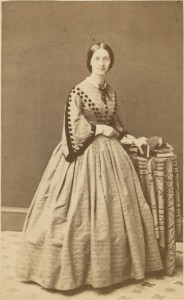 Julia Eliza Tredwell (pictured at right), Seabury and Eliza’s sixth child, was born on May 16, 1833. She was two years old when her father purchased the house on East Fourth Street that would be Julia’s home for the rest of her life. Many books in the Tredwell Book Collection bear her name, including several on French language and grammar, natural history, poetry, and mathematics.
Julia Eliza Tredwell (pictured at right), Seabury and Eliza’s sixth child, was born on May 16, 1833. She was two years old when her father purchased the house on East Fourth Street that would be Julia’s home for the rest of her life. Many books in the Tredwell Book Collection bear her name, including several on French language and grammar, natural history, poetry, and mathematics.
Julia’s Mysterious Illness
In a letter in the museum’s archive, written in August of an unnamed year, Julia expressed her concerns about her health to her mother. She was a guest at the National Hotel in Richfield Springs, a popular spa resort town in upstate New York, where she apparently went to take the “water-cure” to recover from an illness.
“I have felt very much better the past week. They all say I have gained. I feel it, but by weight I only have gained two pounds. I took a bath and I felt stronger as soon as I came out … It is so lonesome to be separated that I feel as if I ought not to stay as long as I have, but I hope in so doing that I will quite gain my strength.”
An Ancient Health Remedy: Water
Although we do not know the nature of the illness that befell Julia that summer, it would certainly not have been unusual for her to seek treatment at a spa hotel that offered the “water-cure,” a 19th century health reform movement that employed the therapeutic use of water to revitalize health and treat disease. Also known as hydrotherapy, it has been practiced since ancient times, when Greeks, Romans, and other early civilizations employed water for medicinal purposes. The perceived therapeutic value of springs rich in minerals such as bromine and sulfur was thought to be attained by a combination of bathing and drinking the water. After waning in the Middle Ages, the popularity of this form of alternative medicine spread throughout Europe and eventually became a craze in the United States, in part as a reaction to the brutal practices of blood-letting, purging, blistering, and other medical treatments of the time, which often worsened the patient’s condition.
The “water-cure” involved various rituals, some less aggressive than others, such as submersion in hot or cold tubs of mineral-rich water for hours at a time; wrapping in cold sheets and then sweating; as well as ingestion of 1-2 liters of foul-tasting mineral water in one sitting. Cold water enema was also considered to be of therapeutic value in treating bowel inflammations and constipation. The “water-cure” was prescribed for the relief of many other ailments, especially gout and arthritis; it offered a gentler alternative to the violent medical therapies typically employed. Dietary remedies, including abstention from coffee, tea, salt, and alcohol, as well as meat and dairy products, were also prescribed.
“For the Invalid and Pleasure Seeker”: Water-Cure and Vacation in One!
By the mid-19th century, the popularity of summer resort towns built around curative springs had soared, especially in New York State. The grand spa hotels typically featured hot and cold water therapy along with dietary and hygienic programs. Ever fearful of the summer cholera and other illnesses caused by the “miasma” that pervaded the air in New York City, those wealthy enough to escape eagerly adopted this fashionable practice, combining their quest for health with a desire for an elite vacation amidst splendid scenery. Among the most popular spa towns were Saratoga Springs, Ballston Spa, and Richfield Springs, which was celebrated for its sulfur water. Located about 65 miles west of Albany, Richfield Springs, where Julia stayed one August, began to draw visitors as early as the 1820s, after Dr. Horace Manley brought 25 patients to take the “water-cure” at his new sanitarium on the site of the Great White Sulphur Springs.
The Water-Cure for New Yorkers, Too
In 1843, Dr. Joel Shew (1816-1865) established a hydropathic treatment business in New York City, the first of its kind in America. He and his wife, Marie Louise Shew, ran the center out of their home on 4th Street, four blocks away from the Tredwell home. In 1845, Dr. Shew founded “The Water-Cure Journal and Herald of Reforms,” which promoted the principles and efficacy of the “water-cure.” Mrs. Shew, herself a staunch promoter of healthy living for women and children, wrote a popular treatise on the benefits of the water-cure, as well as proper diet and exercise, “Water-Cure for Ladies.”
By 1846, the Shews had relocated to 56 Bond Street, just a block from the Tredwells, where their Institution for the Practice of Water-Cure, was “situated in a very airy and pleasant part of up town, New York.” The Shews charged $1 to $2 per day for room and board, medical treatment, and advice, and focused their attention particularly on lung disorders, as “the air of New York is exceedingly bland and favorable for cases of the above-named kind.” The Tredwells may have known of the Shews’ water-cure business; they most likely would have been acquainted with and perhaps even subscribed to the Journal, as it was a very popular periodical of the time, acquiring 50,000 subscribers by 1850. As Dr. Shew stated in his Water-Cure and Health Almanac of 1847:
“…by the judicious use of cold water alone, the good effects of bleeding and blistering are most readily produced, without any of the bad effects, including the pain.”
Mineral Water in Central Park
Even New York City residents who did not have the means to escape the heat and humidity of their home town had access to therapeutic waters. In 1869 Central Park opened its own Mineral Water Pavilion north of the Sheep Meadow, which sold many varieties of spring water with desirable chemical properties thought to promote health and cure illness. Not to be outdone by the offerings of the lavish summer resorts outside of New York City, the Pavilion offered morning summer recitals as an entertainment for the water-ingesting masses. Due to the unprecedented demand for mineral water in the city, merchants in the spa towns took to bottling the mineral water and shipping it to the municipal markets. In the letter to her mother, Julia refers to a neighbor being able to obtain the mineral water from “Cozzens,” who is mentioned in an advertisement in The New York Times, May 16, 1861:
“Sulphur water from these celebrated Springs has been kept for sale, at F.S. Cozzens, number 23 Warren Street.”
Did Julia Recover?
By the turn of the century, with the discovery of germ theory and advances in drug therapy, and as the leisure class sought other forms of entertainment, the popularity of the resort spa towns and the “water-cure” declined. While we don’t know if the “water-cure” proved therapeutic for Julia, or if that was her only foray into a spa town for her health, it most likely did her no harm. She died in 1909 at her home on East 4th Street, at the age of 76.
Sources:
- Bailey, W.T. Richfield Springs and Vicinity. New York: A.S. Barnes & Co., 1874.
- Legan, Marshall Scott. Hydrotherapy, or the Water-Cure in Wrobel, Arthur, ed. Pseudoscience & Society in 19th-Century America. Lexington: The University Press of Kentucky, 1987.
- Miller, Tom. “The Lost Mineral Water Pavilion of Central Park.” Web blog post. Daytonian in Manhattan daytoninmanhattan.blogspot.com. 14 August 2010. Web 20 April 2016.
- Shew, Joel, ed. Water-Cure and Health Almanac for 1847. New York: William H. Graham, 1846.
“The Destroying Angel:” New York’s 1832 Cholera Epidemic
by Ann Haddad
Disturbing News
In the harsh winter of 1831-32, Seabury Tredwell had cause for alarm. As he conducted his business at the seaport and in his warehouse on Pearl Street, he could not have avoided the terrifying news. It was spoken of at every turn, and reported daily in the newspapers: “King Cholera” was heading west! By mid-June, after cutting a path of death as it traveled west from India through Europe, cholera had crossed the Atlantic and reached Canada. If Seabury had kept a journal, most likely he would have written words similar to those of the former New York mayor and diarist Philip Hone, whose entry on June 15 reads:
“It [cholera] must come, and we are in a dreadful state to receive it.
The city is in a more filthy state than Quebec and Montreal.”
Uncle Sam(uel): Bishop, Loyalist … Broadway Star?
by Ann Haddad
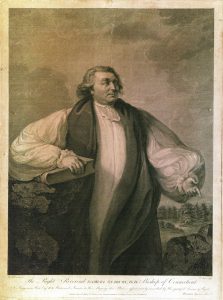 Samuel Seabury |
Early in Act I of Hamilton, as I sat entranced by Lin-Manuel Miranda’s Broadway mega-hit, a rapper in clerical garb mounted a box, and, in a song entitled “Farmer Refuted,” cried out, “Here ye, hear ye! My name is Samuel Seabury and I present…”
I was immediately taken aback. “Samuel Seabury? Seabury Tredwell’s namesake and uncle? Is this the same guy whose portrait adorns one wall in the Tredwell family room? What is he doing here, in a hip-hop musical about Alexander Hamilton?”
Reverend Samuel Seabury (1729-1796), was the half-brother of Seabury Tredwell’s mother, Elizabeth Seabury. Born in Groton, Connecticut, Seabury completed his education at Yale in 1748, and in 1752 earned a degree in medicine at the University of Edinburgh.
One year later, like his father before him, he was ordained into the Episcopal Church in London, and returned to America, where he served as Anglican rector in various parishes in New Jersey, in Queens County, and, during the American Revolution, in St. Peter’s Church in Westchester, New York.
“Seabury Tredwell to Eliza Parker:” A New York City Wedding, June 13, 1820
by Ann Haddad
The entry in the wedding registry of St. George’s Episcopal Church on Chapel (now Beekman) Street, dated June 13, 1820, reads simply “Seabury Tredwell to Eliza Parker.” The tying of the knot between 40-year-old Seabury and 23-year-old Eliza, officiated by the rector, Reverend Dr. James Milnor (1773-1845), was the start of a 45-year union.
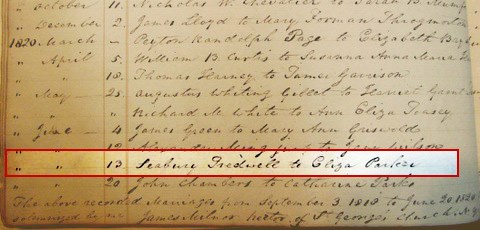
Wedding Registry, St. George’s Episcopal Church
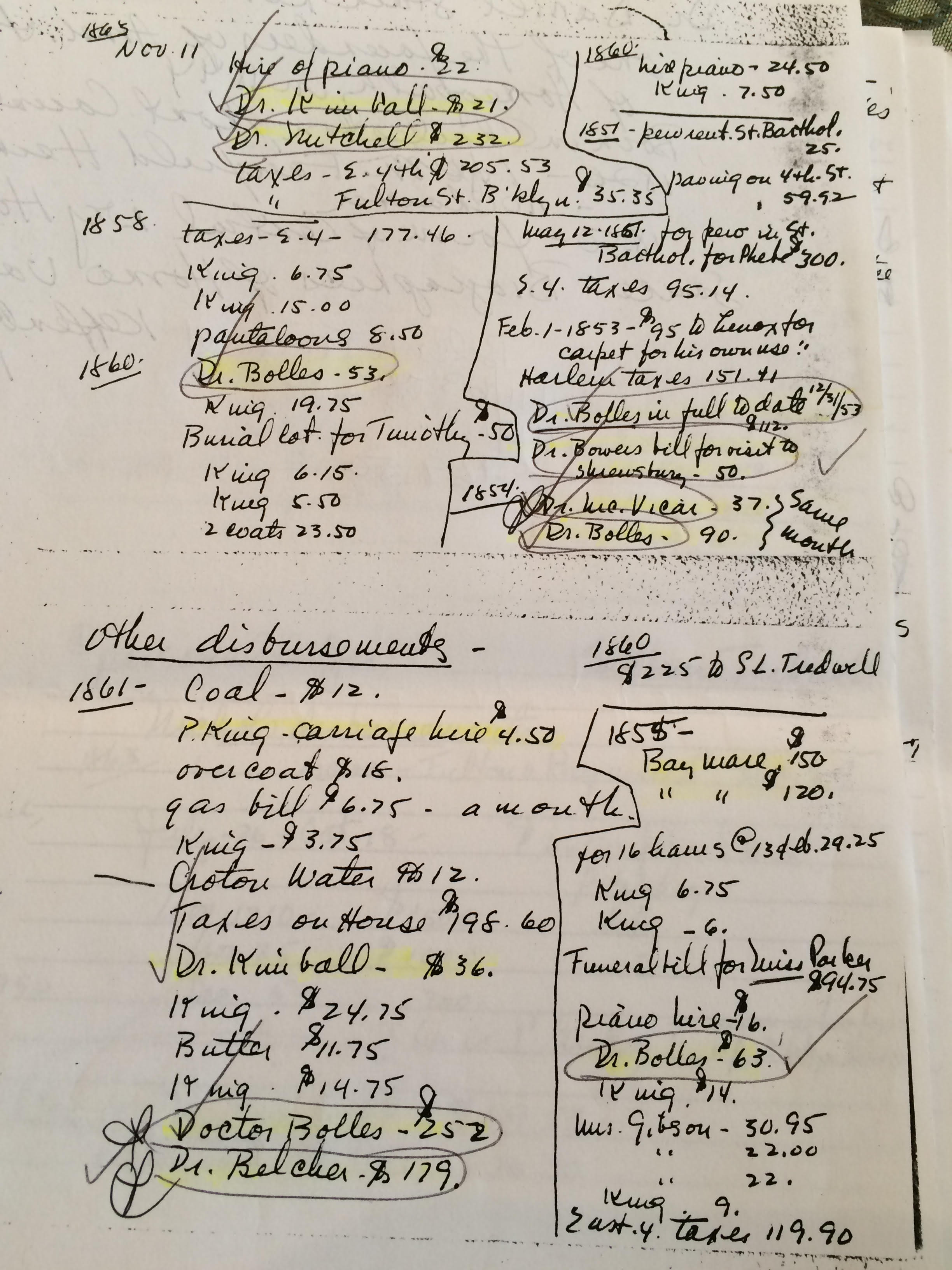
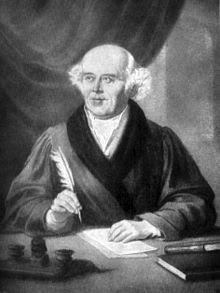
![Henry Monnier. “Allopath and Homeopath argue over method of treatment. [183-]”. (National Library of Medicine.)](https://merchantshouse.org/wp-content/uploads/2016/10/allopath-argue.jpg)
